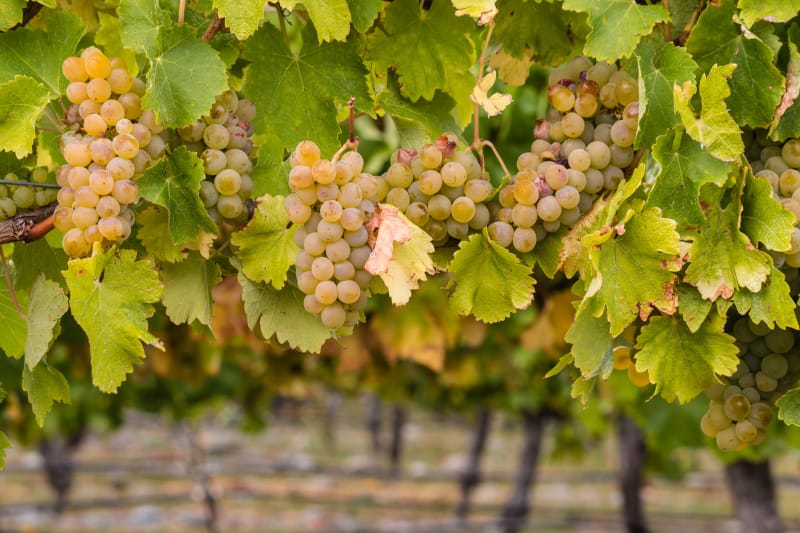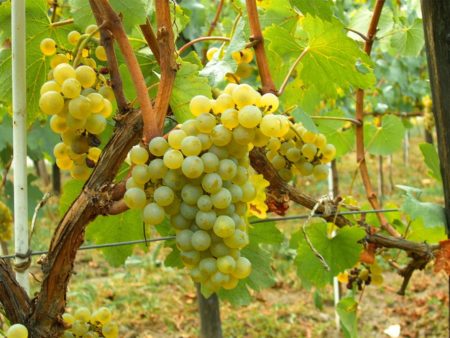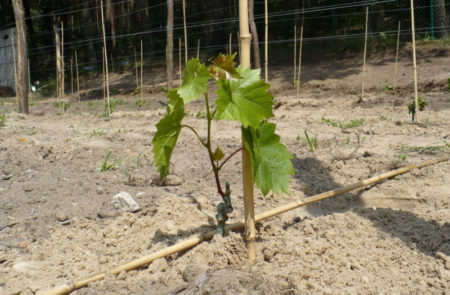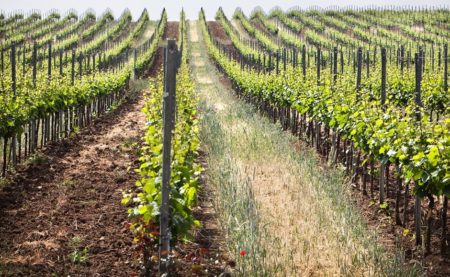
If you ask a person who does not understand grapes to name any varieties for memory, he will call Chardonnay. This variety has gained worldwide popularity, is known in all developed countries and is still actively used there for breeding.
Most often, Chardonnay is grown by whole plantations on an industrial scale, since it is unpretentious in care, and universal in purpose.
Characteristic and Description

The exact date and region of origin of Chardonnay is not known so far. Grape growers suggest that the variety belongs to the Western European species. There is a version according to which grapes were obtained by crossing 2 varieties: Goué blanc and Piro noir. Initially, the variety was bred as technical and was to be used only for processing.
The berries are colored green-white, round in shape, covered with a thin layer of wax. In the sun, plaque acquires a golden hue, which gives the fruit a mouth-watering appearance. The length of the berry is up to 20 mm, and the width is 12 mm. Weight varies from 12 to 15 g. The taste is sweet-sour with a bright fruity aroma. Sugar content - 15-18 g, acid - 8-12 g. Chardonnay has a complex aroma, with notes of lemon, pineapple, walnut and melon intertwined. There are 2-3 grains inside the hollow pulp. The skin is strong but thin.
By maturity are classified as medium early. From the moment of kidney swelling to the planting process, a minimum of 135-140 days passes. Maturation in the southern regions occurs in late August or September. Young shoots ripen well, but the grape yield is low. Of the total number of fruit-bearing shoots, only 1/3 or no more than half. By observing the cultivation technique, it is possible to achieve a yield of 8-12 tons of berries from one planting hectare of land. The main application of Chardonnay is winemaking. The drink is made both at home and in large production. In addition to wine, it is used for making champagne. For fresh consumption, the variety is also suitable. Grape can be used for making compotes, jam, jam.
According to the type of Chardonnay, it is medium and tall. Strong shoots reach a height of more than 5 meters. The leaves on the shoots are jagged, with a bright green color. There is no pubescence. Pollination occurs independently, since the variety belongs to hermaphrodite. The clusters are heavy, 1 kg each. When overripe, the berries fall to the ground. Garter to the trellis is required.
The variety is especially spread on the Black Sea coast with a mild climate and in other southern areas. Chardonnay can be planted in the suburbs, but shelter is recommended. For Siberia and the Urals, the variety may not be suitable. Its frost resistance is low, grapes die at a temperature below - 20 degrees. The immunity of the plant is at an average level. Culture is sometimes ill with mildew and oidium. In conditions of high humidity, the berries rot.
The variety combines both positive aspects and small flaws.
Advantages:
- excellent quality raw materials for winemaking;
- drought tolerance;
- does not require pollinators;
- breeds well.
Disadvantages:
- poor resistance to rot;
- berries are prone to cracking;
- low productivity.
Landing

The soil is prepared in advance. Limestone (1-2 cups per 1 sq.m), compost (1 bucket per 1 sq. M) are added to the ground. All ingredients are dug with soil and left for 2 weeks. Before planting, the ground is well shed with water.You can use Bordeaux liquid (2-3% solution) or copper sulfate (3% solution) - the drugs effectively fight against pathogenic microorganisms and protect the culture from possible infection.
For landing seedlings dig a hole almost a meter deep. Pour gravel bucket and compost bucket into the hole. Insert the seedling into the compost and drop it with the remaining soil. The root neck should remain on the surface of the earth. Immediately after planting, the seedling is tied up and watered with 2-3 buckets of water. After the water is absorbed, lay on a moist earth a layer of mulch - hay, straw or sawdust.
Care

Once a week or 2 weeks, the soil near the plant is loosened. This is necessary to normalize the air exchange of the root system. For loosening, take a chopper or loosen by hand. The procedure should be carried out with extreme caution so as not to damage the young trunk. It is especially good to loosen moist soil, then it is quickly absorbed by water and oxygen.
Chardonnay does not accept frequent watering. Do not water the grapes more than 1 time in 3-4 weeks. During flowering and fruiting, watering should generally be abandoned so as not to spoil the taste of the fruit. Water should be slightly warm. You can put a bucket of water in the sun for a couple of hours, it warms up well. Watering should be in the morning, before noon. Evening watering is dangerous because moisture does not have time to evaporate during the night and leads to decay.
Shelter for the winter
For the southern regions of Chardonnay you can not cover. For the remaining regions, the soil is mulched with straw at the end of autumn, the shoots are bent to the ground, and spruce branches are laid on top. A film or agrofiber is pulled onto the branches and the material is pressed from all sides. In this form, leave grape for winter. Since mid-April, the shelter is dismantled.
Reviews
Most of the opinions of winegrowers agree on one thing: the variety deserves to be praised, even if it has flaws.
Julia from Sochi
“About 12 bushes of Chardonnay grapes grow on my site. This year they turned 4 years old. Berries can be eaten, but they knit a little in the mouth. I grow grapes for homemade wine. I tried to interfere with it with other varieties, I liked it more when only Chardonnay was in the composition. Next year I want to try to separate a couple of cuttings from the main bush and propagate my vineyard. ”
Eugene
“My grapes grow on a hill on a well-lit area. Fruits in plenty, normal productivity. When pruning, I leave 10-12 eyes, clusters then form actively. From top dressing I used superphosphate after flowering (1 tablespoon per 10 l), it seemed to me that the berries became sweeter after it. ”

 Non-covering winter-hardy grape varieties for Moscow region
Non-covering winter-hardy grape varieties for Moscow region How to keep the vine in winter
How to keep the vine in winter When can I transfer grapes to another place in the fall
When can I transfer grapes to another place in the fall How to cover and prepare grapes for the winter in the suburbs
How to cover and prepare grapes for the winter in the suburbs